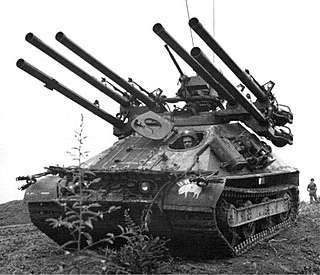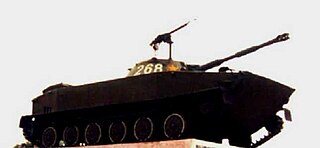
The Army of the Republic of Vietnam composed the ground forces of the South Vietnamese military from its inception in 1955 to the Fall of Saigon in April 1975. At the ARVN's peak, an estimated 1 in 9 citizens of South Vietnam were enlisted, composed of Regular Forces and the more voluntary Regional Forces and the Popular Force militias. It is estimated to have suffered 1,394,000 casualties during the Vietnam War.

Ontos, officially the Rifle, Multiple 106 mm, Self-propelled, M50, was an American light armored tracked anti-tank vehicle developed in the 1950s.

The battle of Dak To in Vietnam was a series of major engagements of the Vietnam War that took place between 3 and 23 November 1967, in Kon Tum Province, in the Central Highlands of the Republic of Vietnam. The action at Đắk Tô was one of a series of People's Army of Vietnam (PAVN) offensive initiatives that began during the second half of the year. PAVN attacks at Lộc Ninh, Sông Bé and at Con Thien and Khe Sanh,, were other actions which, combined with Đắk Tô, became known as "the border battles". The post hoc purported objective of the PAVN forces was to distract American and South Vietnamese forces away from cities towards the borders in preparation for the Tet Offensive.

The M48 Patton is an American first-generation main battle tank (MBT) introduced in February 1952, being designated as the 90mm Gun Tank: M48. It was designed as a replacement for the M26 Pershing, M4 Sherman, M46 and M47 Patton tanks, and was the main battle tank of the U.S. Army and U.S. Marine Corps in the Vietnam War. Nearly 12,000 M48s were built, mainly by Chrysler and American Locomotive Company, from 1952 to 1961. The M48 Patton was the first U.S. medium gun tank with a four-man crew, featuring a centerline driver's compartment and no bow machine gunner. As with nearly all new armored vehicles it had a wide variety of suspension systems, cupola styles, power packs, fenders and other details among individual tanks.

The PT-76 is a Soviet amphibious light tank that was introduced in the early 1950s and soon became the standard reconnaissance tank of the Soviet Army and the other Warsaw Pact armed forces. It was widely exported to other friendly states, like India, Indonesia, Iraq, Syria, North Korea and North Vietnam.

The Battle of Lang Vei began on the evening of 6 February 1968 and concluded during the early hours of 7 February, in Quảng Trị Province, South Vietnam. Towards the end of 1967, the 198th Tank Battalion of the People's Army of Vietnam's (PAVN) 202nd Armored Regiment received instructions from the North Vietnamese Ministry of Defense to reinforce the 304th Division as part of the Route 9–Khe Sanh Campaign. After an arduous journey down the Ho Chi Minh trail in January 1968, the 198th Tank Battalion linked up with the 304th Division for an offensive along Highway 9, which stretched from the Laotian border through to Quảng Trị Province. On 23 January, the 24th Regiment attacked the small Laotian outpost at Bane Houei Sane, under the control of the Royal Laos Army BV-33 "Elephant" Battalion. In that battle, the 198th Tank Battalion failed to reach the battle on time because its crews struggled to navigate their tanks through the rough local terrain. However, as soon as the PT-76 tanks of the 198th Tank Battalion turned up at Bane Houei Sane, the Laotian soldiers and their families retreated into South Vietnam.

The M107 175 mm (6.9 in) self-propelled gun was used by the U.S. Army and U.S. Marine Corps from the early 1960s to the late 1970s. It was part of a family of self-propelled artillery that included the M110. It was intended to provide long-range fire support in an air-transportable system. It was exported to several other countries including Germany, South Korea, Spain, Greece, Iran, Israel, Italy, the Netherlands, the United Kingdom, and Turkey. The M107's combat history in U.S. service was limited to the Vietnam War; it also saw extensive combat use in Israeli service. The M107 shared many components with, and in many cases was replaced by, later versions of the M110 203 mm (8.0 in) howitzer. Although withdrawn from U.S. service in the late 1970s, it continues to see military service as of 2024.

The BTR-50 is a Soviet tracked amphibious armored personnel carrier (APC) based on the PT-76 light tank chassis. The BTR-50 was developed in 1952 and entered service with the Soviet Army in 1954. It ceased production in the USSR in 1970, but production continued in Czechoslovakia until 1972 and there is suggestion that it still produced by some foreign companies. It has the ability to transport up to 20 fully equipped infantrymen, and can be armed with nothing, a 7.62 mm SGMB medium machine gun, or a 14.5 mm KPV heavy machine gun. It saw notable service in the Six-Day War, the Yom Kippur War, and most recently in the Russo-Ukrainian War.
Tank development both evolved considerably from World War II and played a key role during the Cold War (1945–1990). The period pitted the nations of the Eastern Bloc and the North Atlantic Treaty Organization (NATO against each other.

Camp Carroll was a United States Marine Corps and Army of the Republic of Vietnam (ARVN) artillery base during the Vietnam War. It was located 8 km southwest of Cam Lộ, Quang Tri Province. Camp Carroll was also at the centroid of a large arc of the strategic Highway 9 corridor south of the Vietnamese Demilitarized Zone (DMZ), which made it a key facility.

Con Thien was a military base that started out as a U.S. Army Special Forces camp before transitioning to a United States Marine Corps combat base. It was located near the Vietnamese Demilitarized Zone (DMZ) about 3 kilometers (1.9 mi) from North Vietnam in Gio Linh District, Quảng Trị Province. It was the site of fierce fighting from February 1967 through February 1968.
The lead-up to the Battle of Kontum began in mid-1971, when North Vietnam decided that its victory in Operation Lam Son 719 indicated that the time had come for large-scale conventional offensives that could end the war quickly. The resulting offensive, planned for the spring of 1972, would be known as the Easter Offensive in the South and the Nguyen Hue Offensive in the North, Nguyen Hue being a hero of Vietnamese resistance against the Chinese in 1789. The Easter Offensive would make use of fourteen divisions and would be the largest in the war.

The First Battle of Quảng Trị resulted in the first major victory for the People's Army of Vietnam (PAVN) during the Easter Offensive of 1972. Quảng Trị Province was a major battleground for the opposing forces during the Vietnam War. As South Vietnamese soldiers were gradually replacing their American counterparts, North Vietnam's General Văn Tiến Dũng was preparing to engage three of his divisions in the province. Just months before the battle, the Army of the Republic of Vietnam (ARVN) deployed its newly formed 3rd Division to the areas along the Vietnamese Demilitarized Zone (DMZ) to take over former US bases. North Vietnamese forces deployed against the inexperienced ARVN 3rd Division included the PAVN 304th, 308th and 324B Divisions.

Phase Two of the Tet Offensive of 1968 was launched by the People's Army of Vietnam (PAVN) and Viet Cong (VC) against targets throughout South Vietnam, including Saigon from 29 April to 30 May 1968. The May Offensive was considered much bloodier than the initial phase of the Tet Offensive. U.S. casualties across South Vietnam were 2,169 killed for the entire month of May, making it the deadliest month of the entire Vietnam War for U.S. forces, while South Vietnamese losses were 2,054 killed. PAVN/VC losses exceeded 24,000 killed and over 2,000 captured. The May Offensive was a costly defeat for the PAVN/VC.

This article deals with the history and development of American tanks from the end of World War II and during the Cold War.
The second battle of Bàu Bàng occurred during the night of 19–20 March 1967 during Operation Junction City, a search and destroy mission by American military forces in Tay Ninh Province of South Vietnam, to the west of the capital Saigon.

Ben Het Camp is a former U.S. Army and Army of the Republic of Vietnam (ARVN) base northwest of Kon Tum in the Central Highlands of Vietnam. The camp was notable for being the site of a tank battle between the U.S. Army and the People's Army of Vietnam (PAVN), one of the few such encounters during the Vietnam War.
Operation El Paso and Operation El Paso II were operations conducted during the Vietnam War by the U.S. Army's 3rd Brigade of the 1st Infantry Division in Bình Long Province, lasting from 19 May to 13 July 1966.
The 20th Tank Regiment was a unit of the Army of the Republic of Vietnam (ARVN), the South Vietnamese army. The 20th Tank Regiment was organized on 31 July 1971 and soon saw extensive combat during the 1972 Easter Offensive.
Operation MacArthur was a United States Army military operation in the Central Highlands of South Vietnam from 12 October 1967 to 31 January 1969. The early phases of the operation encompassed the Battle of Dak To from 3 to 23 November 1967.














